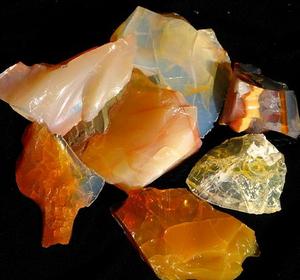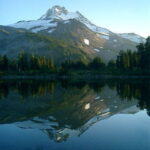No single word can describe opal. Incredible iridescence and rainbow colors in vivid intensity characterize the stone. Colors fade into pearly or milky white or even a clear, nearly colorless, glassy background. The word ‘opal’ conjures up a complex beauty that only the mind’s eye can articulate accurately.
Opal is a fairly simple molecule. A hydrated silicon dioxide, opal’s chemical formula is SiO2.nH2O. The n means that any number of water molecules can be associated with each SiO2 molecule. More accurately, the number of waters varies, is unknown, or both. In other words, n means we don’t know.
What we do know about opal is that it should not be allowed to dry out. Crazing occurs when opal loses some or all of its hydration. Crazing is another word for internal cracking. (Could this be how we got the word ‘crazy’?) The stone does not split open nor fall apart, but the internal structure becomes cracked and compromised. I suppose this makes opal the only gemstone that can become crazed!
Opal was found in the early 1800s in what is now Opal Butte, Oregon. Only in recent times have the deposits been mined. Late in the 1980s, West Coast Gemstones, a mining company, opened large deposits to mining and extraction of opal occurring as nodules, inside geodes or thundereggs, as they are called. Sizes range from golfball- or baseball-sized nodules to small boulders. And they are 65 million years old, formed from the flow of ancient lava in the mountain area now known as northern central Oregon.
The opal from Opal Butte is called Opal Butte opal. (Makes one wonder whether opal was named after the place where it was found, or the place named after the opal found there….) No matter. The opal found there shows in vibrant intense colors of reds, orange, pink, gold, and brown. Thus, the name ‘fire opal’ aptly characterizes the opal of the Opal Butte area.
Opal roughs dug from the many surface mines in the region show as glassy rock shards. They can cut as easily as glass, so care must be practiced while digging for opal. Yes, many mines are open for fee-digging. This is digging your own. Opal, that is, for a fee, of course. With a lot of hard, hot work and lots of muscle, serious rock-cutting equipment, thick gloves for hand protection and plenty of water-like opal, one needs to stay hydrated while splitting rocks-you can get a bucket of opal for a couple hundred bucks. If you ask me, that’s a much too moderate return for such a large expenditure of personal resources–mental, physical, and financial.
If you’re like me, you opted out of hard labor in the mines for a trip to southern Arizona, where opal roughs from Opal Butte are offered for sale at the Tucson Gem Show. This is where several incredible specimens of mined Opal Butte opal became mine. (Honestly, that play on words just popped into the story!) Intense color was the attractor for me to the opal stones. My mental image of ‘opal’ was not what I observed. Rather, glassy stones of orange fire gave rise to images of fine finished jewelry that I would fashion from the incredible opal.
Opal Butte opal is like no other opal from anywhere. Recognize this stunning gemstone by its orange fire.
Sources: http://minerals.usgs.gov/minerals/pubs/commodity/gemstones/sp14-95/opal.html
www.opalcolorsoregon.com



